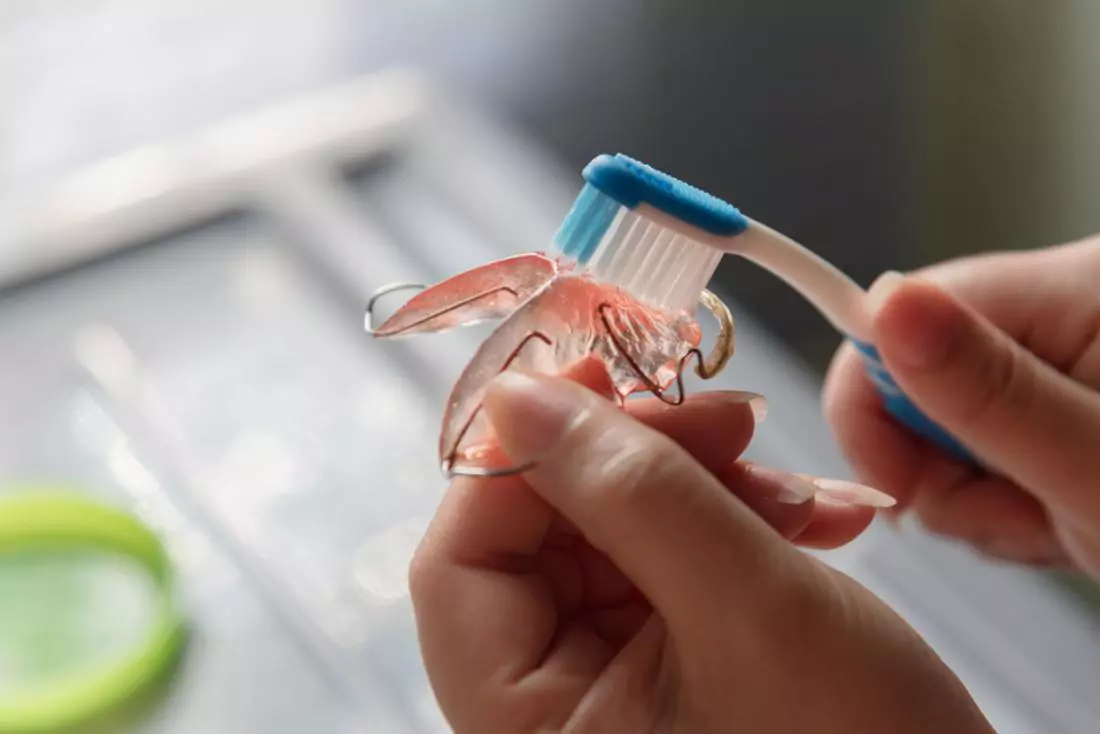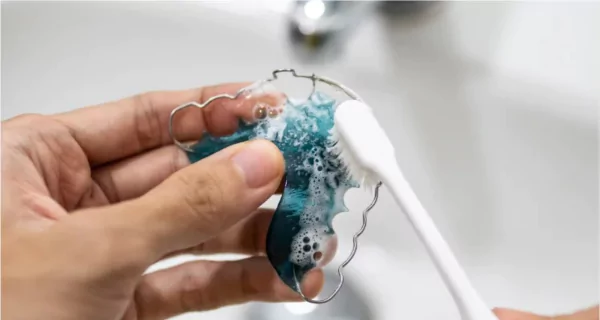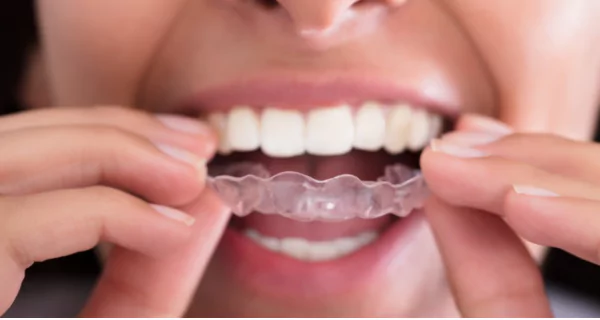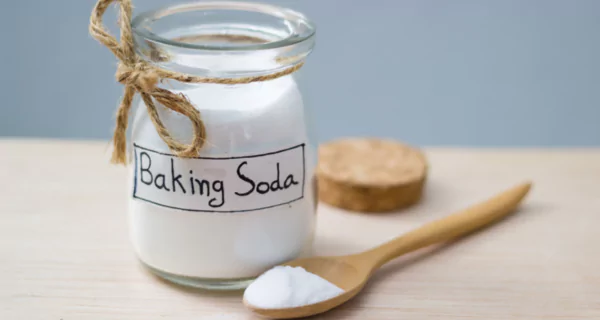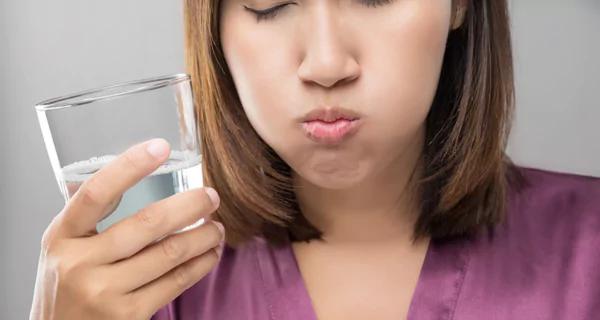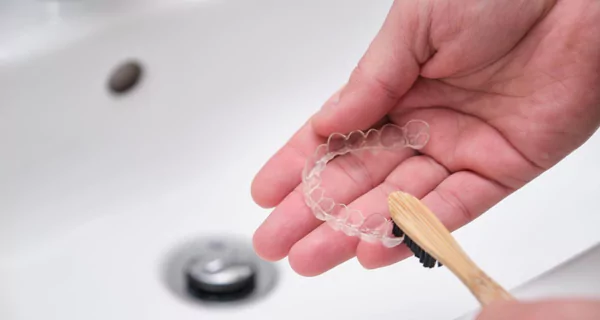Last Updated on: 19th September 2025, 12:36 pm
Learn how to make DIY retainer cleaner at home with safe, effective methods. Discover tips to clean retainers and keep them fresh without harsh chemicals.
Retainers play a vital role in maintaining the alignment of your teeth after orthodontic treatment. However, like any dental appliance, they require regular cleaning to prevent bacteria buildup, bad odors, and staining.
Retainers are worn for many hours a day, often according to your orthodontist’s instructions, which might range from at least 8 hours a night to attempting to wear them 24 hours a day, only removing them for meals. This means they spend most of their time in a humid, dark environment, those are ideal conditions for bacteria, plaque, and food debris to accumulate if not cleaned properly, much like your teeth. While commercial cleaning solutions are readily available, many people prefer DIY cleaners as a cost-effective, natural, and convenient alternative.
This guide offers dentist-approved tips for cleaning your retainer at home, using safe and effective methods that don’t compromise its integrity. By the end of this article, you’ll have all the tools you need to keep your retainer fresh and hygienic.
Why clean your retainer regularly?
Wearing an unclean retainer can lead to various oral health issues. Bacteria, plaque, and food particles can build up on its surface, creating an ideal environment for harmful microorganisms to thrive. Here’s what could happen:
- Bad breath (halitosis): Accumulation of bacteria on the retainer contributes to unpleasant odors in your mouth.
- Infections: A dirty retainer can harbor harmful bacteria and fungi, potentially leading to oral health issues like gum irritation or infections like oral thrush.
- Gum problems: A dirty retainer can harbor bacteria that irritate the gums, leading to swelling, inflammation, and eventually gum disease.
- Tooth damage: An unclean retainer can accumulate plaque, which increases the risk of tooth decay and the development of cavities.
- Reduced lifespan: Failing to maintain proper hygiene can degrade the material of your retainer, shortening its lifespan, and possibly requiring a replacement sooner than expected.
Your retainer likely needs a thorough cleaning if you notice any of the following:
- Stains or discoloration: Retainers can become stained or appear foggy when not cleaned regularly.
- Visible buildup: Check for any noticeable buildup of plaque or food debris. It may look cloudy or have a yellowish hue.
- Bad smell: A persistent unpleasant odor, even after rinsing, is a clear sign of bacterial buildup.
- Unusual taste: If your retainer tastes off or different from normal, it’s likely time for a cleaning.
- Sticky or slimy texture: A retainer that feels sticky or slippery to the touch may be coated with bacteria and plaque.
- Oral health changes: An increase in bad breath, gum irritation, or other dental issues could be linked to wearing an unclean retainer.
Changes in oral health, such as worsening bad breath, irritated gums, or other dental problems, might be connected to using a dirty retainer. Consistent cleaning helps keep your retainer hygienic, safe to use, and effective in preserving your smile.
What to avoid when cleaning retainers
Before exploring DIY methods for cleaning your retainer, it’s essential to understand what practices to avoid to prevent damage:
- Avoid boiling water: Never use hot or boiling water to clean your retainer. Excessive heat can distort its shape, making it unfit for use. Stick to lukewarm or cool water for cleaning.
- Don’t use abrasive tools: Toothpaste and hard-bristled brushes may seem like good options, but they can scratch the surface of your retainer. These scratches create small crevices where bacteria can thrive, compromising cleanliness.
- Stay away from harsh chemicals: Strong chemicals like bleach or harsh cleaning agents can weaken the material of your retainer and leave behind harmful residues that could be ingested.
- Avoid dishwasher cleaning: Although it might appear convenient, dishwashers produce high heat and intense water pressure that can damage or warp your retainer.
By keeping these tips in mind, you can protect the integrity and functionality of your retainer while ensuring it remains clean and safe to use.
5 DIY retainer cleaner recipes you can try
Here are five dentist-approved, simple DIY retainer cleaners you can easily make at home.
Baking soda
Baking soda is a natural, affordable cleaner that removes stains and plaque while neutralizing odors and bacteria. Its gentle abrasiveness makes it safe for regular use without damaging your retainer, offering a reliable and hygienic cleaning option.
Instructions for use:
- Mix 2 tablespoons of baking soda with 1 cup of lukewarm water in a container until fully dissolved.
- Submerge your retainer in the solution, ensuring it is completely covered, and let it soak for 15–30 minutes.
- Scrub your retainer with a soft-bristled toothbrush to remove any remaining debris or buildup.
- Rinse your retainer thoroughly under lukewarm water to wash away any residual baking soda.
Use this method regularly to keep your retainer fresh and clean.
White vinegar
White vinegar is a natural disinfectant that removes bacteria, odors, and tartar buildup from your retainer. Its acidity dissolves plaque safely and affordably, keeping your retainer fresh and hygienic.
Instructions for use:
- Mix equal parts of white vinegar and water in a bowl or glass.
- Submerge your retainer in the mixture, making sure it is fully covered, and let it soak for 20–30 minutes.
- Rinse the retainer thoroughly under running water to remove any residue or lingering vinegar taste.
Use this method periodically for deep cleaning, but avoid overuse, as vinegar’s acidity could damage some delicate retainer materials with excessive exposure.
Hydrogen peroxide
Hydrogen peroxide is an effective antibacterial that sanitizes your retainer, eliminating bacteria, odors, and stains. Its gentle action makes it safe for regular use, keeping your retainer clean and fresh.
Instructions for use:
- Mix equal parts of 3% hydrogen peroxide and lukewarm water in a small container.
- Place your retainer in the solution, ensuring it is fully submerged, and let it soak for 10–15 minutes.
- Use a soft-bristled toothbrush to gently scrub the retainer, removing any residue or debris
- Rinse the retainer thoroughly under running water to remove any remaining hydrogen peroxide.
Use this method occasionally to sanitize your retainer and maintain its hygiene.
Lemon juice soak
Lemon juice is a natural, eco-friendly cleaner that removes plaque and tartar while leaving a fresh citrus scent. Its mild acidity is gentle on retainer materials and keeps them hygienic affordably.
Instructions for use:
- Mix one part lemon juice with three parts water in a cup or small container.
- Submerge your retainer completely in the solution and let it soak for 15–20 minutes.
- Rinse the retainer thoroughly under running water to remove any acidic residue that could damage the material if left behind.
Use this method sparingly, as frequent exposure to acid may weaken some types of retainer materials over time.
Saltwater rinse
Saltwater is a gentle, natural cleaner with antibacterial properties that keep your retainer hygienic and odor-free. Safe for daily use, it’s affordable, non-damaging, and perfect for regular maintenance.
Instructions for use:
- Mix 1 teaspoon of salt into 1 cup of warm water, stirring until the salt is fully dissolved.
- Submerge your retainer in the solution and let it soak for about 15 minutes.
- Rinse the retainer thoroughly with cool water to remove any salty residue before wearing it.
This simple cleaning routine can be done daily to maintain your retainer’s cleanliness and ensure its longevity.
How to maintain retainer hygiene daily
In addition to periodic deep cleaning with DIY methods, practicing good daily habits is essential to keep your retainer clean and in good condition.
- Rinse regularly: After removing your retainer, rinse it immediately with lukewarm water to remove saliva and any debris.
- Brush lightly: Use a soft-bristled toothbrush (without toothpaste) to gently clean the surface and prevent buildup.
- Let it dry: Always allow your retainer to air-dry completely before storing it to reduce the risk of bacteria or mold forming.
- Maintain a clean case: Regularly wash your retainer case with soap and water to ensure it stays hygienic and free of germs.
- Don’t eat while wearing it: Eating with your retainer on can trap food particles and bacteria, increasing the chance of plaque buildup and odors.
These daily practices help extend your retainer’s lifespan while keeping it fresh and safe to use.
Benefits of DIY retainer cleaners
Opting for DIY retainer cleaners has several advantages over commercial options:
- Cost-effective: Most DIY recipes use household ingredients, making them affordable.
- Convenient: Clean your retainer anytime without needing to purchase specialized products.
- Safe and natural: DIY solutions avoid harsh chemicals, reducing the risk of irritation.
- Environmentally friendly: No disposable cleaning tablets or excessive packaging.
Properly cleaning your retainer is crucial for both your oral health and the durability of the appliance. DIY retainer cleaners provide an affordable, gentle, and effective solution to maintain cleanliness without the need for costly or chemical-heavy products.
By using the methods and advice outlined in this guide, you can easily clean your retainer at home, keeping it fresh, free of odors, and in good condition. Combined with consistent oral hygiene, regular care will help preserve your smile and ensure your retainer functions at its best.
Frequently Asked Questions
Can I use toothpaste to clean my retainer?
Can I eat while wearing my retainer?
How often should I clean my retainer?
Can DIY cleaners damage retainers?
What should I do if my retainer smells bad?
Share
References
1. Akgun, F. A., Senisik, N. E., & Cetin, E. S. (2019, december 1). Evaluation of the Efficacy of Different Cleaning Methods for Orthodontic Thermoplastic Retainers in terms of Bacterial Colonization. Turkish Journal Of Orthodontics, 32(4), 219-228. https://doi.org/10.5152/turkjorthod.2019.19061
2. Marcin, A. (2019, March 8). How to Clean Each Type of Retainer. Healthline. https://www.healthline.com/health/dental-and-oral-health/how-to-clean-retainers
3. Millhone, C. (2023, october 28). How to Best Clean Retainers—And Why You Should Be Doing That In the First Place. Health. https://www.health.com/how-to-clean-retainers-8363013
4. Tan, S. (2022, april 9). How to Clean Your Retainer. WebMD. https://www.webmd.com/oral-health/how-to-clean-your-retainer
5. Villines, Z. (2024, January 24). 8 tips for cleaning a retainer. Medical news Today. https://www.medicalnewstoday.com/articles/317894
-
Nayibe Cubillos M. [Author]
Pharmaceutical Chemestry |Pharmaceutical Process Management | Pharmaceutical Care | Pharmaceutical Services Audit | Pharmaceutical Services Process Consulting | Content Project Manager | SEO Knowledge | Content Writer | Leadership | Scrum Master
View all posts
A healthcare writer with a solid background in pharmaceutical chemistry and a thorough understanding of Colombian regulatory processes and comprehensive sector management, she has significant experience coordinating and leading multidisciplina...



